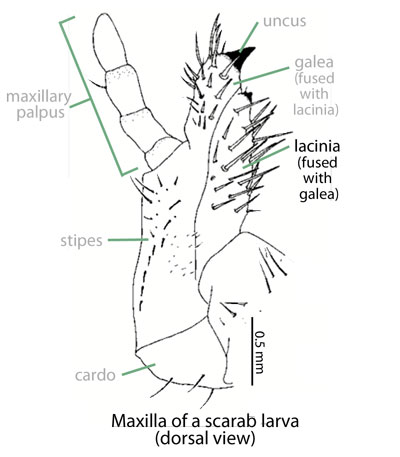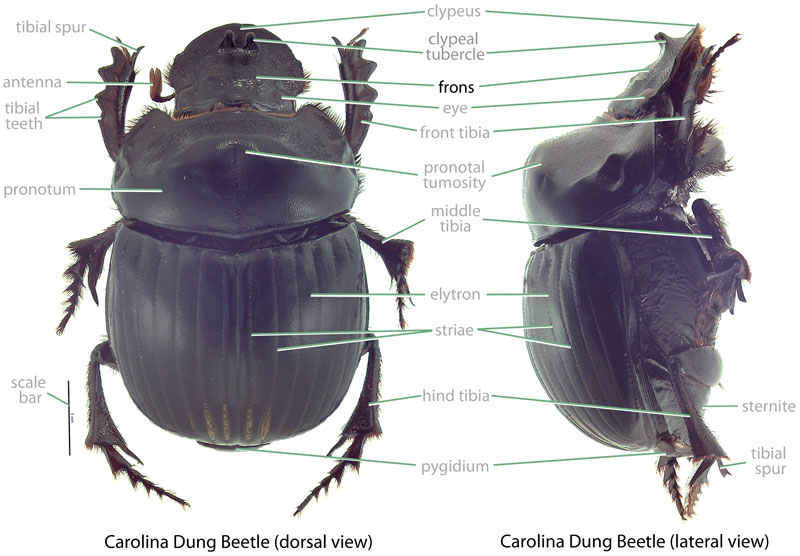Beneficial
greater sandy dung beetle
Family: Scarabaeidae Subfamily: Scarabaeinae Genus: Euoniticellus Species: Euoniticellus africanus (Harold, 1873)
none available
Total body length 7.0–13.0 cm (0.26–0.51 in). Body oblong, somewhat dorsoventrally compressed; may be caked in dung. Color tan to grayish-brown with dark brown markings. Clypeusclypeus:
part of the head anterior to the frons; the most anterior portion in dorsal view
 with distinct ridge at anterioranterior:
with distinct ridge at anterioranterior:
the front or forward; opposite of posterior
margin in male; anterioranterior:
the front or forward; opposite of posterior
ridge lacking in female. Frontoclypeal suturefrontoclypeal suture:
transverse suture between the clypeus and frons
with inverted V-shaped ridge in male; female lacking ridge. Ocular canthuscanthus:
a process extending over and sometimes dividing the eye
quadrately produced. Pronotumpronotum:
the dorsal surface of the thorax
 of male somewhat hump-like when viewed laterally. Tibiatibia:
of male somewhat hump-like when viewed laterally. Tibiatibia:
a segment of the leg articulated with the tarsus and femur
 of female robust; male tibiatibia:
of female robust; male tibiatibia:
a segment of the leg articulated with the tarsus and femur
 comparatively gracilegracile:
comparatively gracilegracile:
thin, slender, light of build
.
Undescribed: For Scarabaeinae (Ritcher, 1966Ritcher, 1966:
Ritcher P. 1966. White grubs and their allies: a study of North American scarabaeoid larvae. Oregon State University Monographs, Studies in Entomology 4: 1-219.): Grub C-shaped, hump-backed, cylindrical, and cream-colored. Maxillamaxilla:
set of paired mouthparts located posterior to the mandibles
with galeagalea:
outer branch or lobe of the maxilla
 and lacinialacinia:
and lacinialacinia:
inner portion of the maxilla distinctly separate. AntennaeAntennae:
distinctly separate. AntennaeAntennae:
paired sensory organ on head, formed from numerous segments
 with 4 or 5 apparent segments. Distaldistal:
with 4 or 5 apparent segments. Distaldistal:
situated away from the point of articulation, thus usually furthest from the body
segment of antennaantenna:
paired sensory organ on head, formed from numerous segments
 much reduced in size. Epipharynxepipharynx:
much reduced in size. Epipharynxepipharynx:
lobe on the interior surface of the labrum or clypeus
with tormaetormae:
in scarab larvae, sclerotized structures on the ends of the clypeolateral suture extending towards the mesal line
united mesallymesally:
at or near midline of body
, anterioranterior:
the front or forward; opposite of posterior
phoba present. Legs 2-segmented. Anal opening surrounded by fleshy lobes.
Southern Africa. This species is native to southern Africa where it is known from Lesotho, Mozambique, and South Africa (Tyndale-Biscoe, 1990Tyndale-Biscoe, 1990:
Tyndale-Biscoe M. 1990. Common dung beetles in pastures of southeastern Australia. CSIRO Publishing, Clayton, Australia.). It has been introduced to Australia (Tyndale-Biscoe, 1990Tyndale-Biscoe, 1990:
Tyndale-Biscoe M. 1990. Common dung beetles in pastures of southeastern Australia. CSIRO Publishing, Clayton, Australia.).
None. Euoniticellus spp. feed on dung as both adults and larvaelarvae:
the immature form of an insect; in scarabs, also called grub or white grub; preceded by the egg stage, followed by the pupal stage
 (Hull et al., 2013Hull et al., 2013:
(Hull et al., 2013Hull et al., 2013:
Hull R, Alaouna M, Khanyile L, Bryne M, Ntwasa M. 2013. Lifestyle and host defense mechanisms of the dung beetle, Euoniticellus intermedius : the toll signaling pathway. Journal of Insect Science 13: 1-25. full text (accessed 2015)).
Poorly known. Adults of this species prefer a slightly cooler climate than the related intermediate sandy dung beetle (Euoniticellus intermedius) (Edwards, 2007Edwards, 2007:
Edwards P. 2007. Introduced dung beetles in Australia 1967-2007. Landcare Australia, Sydeny, New South Wales, Australia. full text (accessed 2015)). In related species of Euoniticellus, adults are diurnaldiurnal:
active during daylight hours
dung tunnelers (Blume, 1984Blume, 1984:
Blume R. 1984. Euoniticellus intermedius (Coleoptera: Scarabaeidae): description of adults and immatures and biology of adults. Environmental Entomology 13: 1064-1068. full text (accessed 2015)). Working together, a male and female dig a burrow beneath a dung source. Dung is used to line the burrow and create a brood mass. The brood mass is created at the end of the burrow and impregnated with a single egg. Multiple brood masses, each with its own egg, can occupy the same burrow. LarvaeLarvae:
the immature form of an insect; in scarabs, also called grub or white grub; preceded by the egg stage, followed by the pupal stage
 develop within the mass where they feed on the dung (Blume, 1984Blume, 1984:
develop within the mass where they feed on the dung (Blume, 1984Blume, 1984:
Blume R. 1984. Euoniticellus intermedius (Coleoptera: Scarabaeidae): description of adults and immatures and biology of adults. Environmental Entomology 13: 1064-1068. full text (accessed 2015)).
None. This species recycles dung and is beneficial for ranching and farming in Hawaii. Being a dung feeder, this species poses no threat to crop or ornamental plants. Additionally, this species is not a threat to native dung beetles because none are known from Hawaii or Guam.
Established. This dung beetle was intentionally released in 1974 at Parker Ranch on Big Island to help control populations of the horn fly (Haematobia irritans), a biting pest of livestock (Nakao and Funasaki, 1976Nakao and Funasaki, 1976:
Nakao H and Funasaki G. 1976. Introductions for biological control in Hawaii, 1974. Proceedings of the Hawaiian Entomological Society 22: 329-331. full text (accessed 2015)). Nishida (2002) reported it as being established on the Big Island.
Not established or recorded. There are no records of this species from Guam.
In Hawaii, this species was intentionally introduced.
The greater sandy dung beetle (Euoniticellus africanus) is one of two Euoniticellus species known from Hawaii, the other recorded species being the very similar intermediate sandy dung beetle (Euoniticellus intermedius). The two scarabs can be separated by examination of the fronsfrons:
part of the head generally positioned between the eyes (posterior to the clypeus and anterior to the vertex) and visible dorsally
 (E. africanus male lacking a horn and female with a V-shaped anterioranterior:
(E. africanus male lacking a horn and female with a V-shaped anterioranterior:
the front or forward; opposite of posterior
ridge versus E. intermedius male with a horn on fronsfrons:
part of the head generally positioned between the eyes (posterior to the clypeus and anterior to the vertex) and visible dorsally
 and female with slightly curved transversetransverse:
and female with slightly curved transversetransverse:
extending horizontally across a surface
ridge on the fronsfrons:
part of the head generally positioned between the eyes (posterior to the clypeus and anterior to the vertex) and visible dorsally
 ).
).
Oniticellus africanus Harold
Report your observation of this beneficial species at our iNaturalist project.